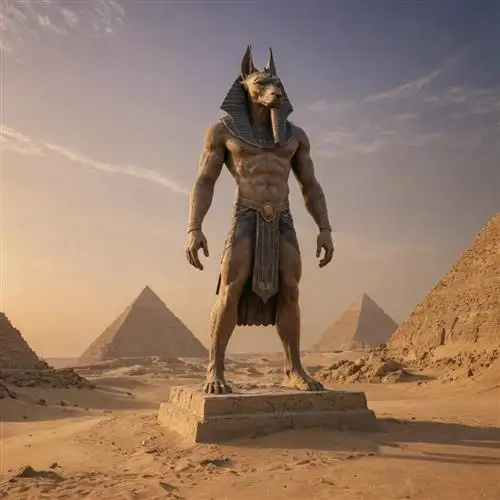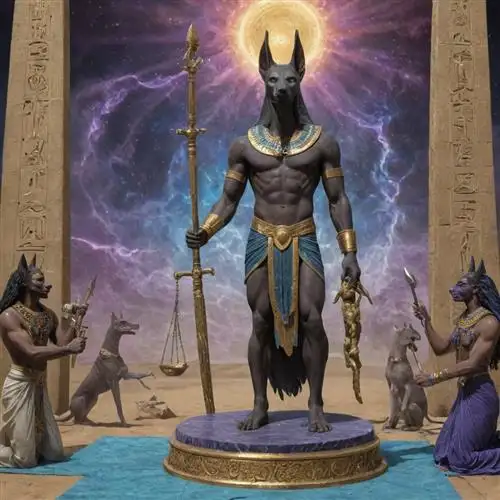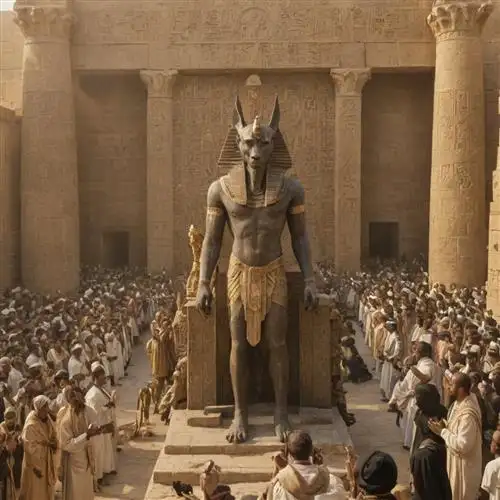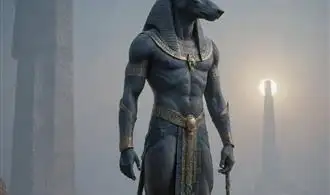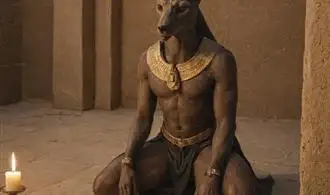
The Origin of Anubis
Anubis, the jackal-headed god of ancient Egyptian mythology, has long captivated the imaginations of scholars and enthusiasts alike. His origins can be traced back to the earliest periods of Egyptian civilization, where he played a crucial role in the rituals and beliefs surrounding death and the afterlife.
One of the earliest known references to Anubis can be found in the Coffin Texts, dating back to the Middle Kingdom (2040-1650 BCE). These ancient texts describe Anubis as the god responsible for the embalming and mummification of the deceased, guiding them through the perilous journey to the afterlife. This connection to the funerary rites and the underworld cemented Anubis' status as a pivotal figure in the Egyptian pantheon.
The origins of Anubis' iconography and symbolism are believed to stem from the ancient Egyptian practice of mummification and the role of the jackal in this process. Jackals were often observed in and around ancient Egyptian necropolises, scavenging the bodies of the dead. This association with death and the underworld led to the jackal being revered as a sacred animal, and ultimately to the depiction of Anubis with the head of a jackal.
The precise origins of the Anubis cult are not entirely clear, but it is believed to have originated in the region of Abydos, a site of great importance in ancient Egyptian religion. Abydos was the home of the Osirion, a temple complex dedicated to the god Osiris, the ruler of the underworld. Anubis' role as the guardian and embalmer of the dead was closely tied to the cult of Osiris, further solidifying his place in the Egyptian pantheon.
Over time, Anubis' influence and importance grew, and he came to be associated with a wide range of funerary and afterlife-related rituals and beliefs. He was responsible for weighing the hearts of the deceased against the feather of Ma'at, the goddess of truth and justice, to determine their worthiness for the afterlife. Anubis was also seen as a protector of the dead, guarding their tombs and ensuring the safe passage of the soul to the afterlife.
Anubis Role in Egyptian Mythology
Anubis, the ancient Egyptian god of the dead, played a crucial role in the intricate tapestry of Egyptian mythology. As the guardian of the necropolis and the embalming process, Anubis was revered for his ability to navigate the complex journey of the afterlife. His significance extended far beyond his role as the protector of the dead, as he was also responsible for guiding the souls of the deceased through the treacherous underworld.
In the Egyptian belief system, the afterlife was a crucial aspect of the human experience, and Anubis was the gatekeeper to this realm. His unique position as the embalmer and protector of the dead made him an indispensable figure in the rituals and ceremonies that were integral to the transition from the mortal world to the eternal one. As such, the ancient Egyptians revered Anubis with a deep sense of reverence and devotion, seeking his guidance and protection in the face of the unknown.
Anubis' role in Egyptian mythology was not limited to the afterlife alone. He was also closely associated with the process of mummification, which was essential in preserving the physical form of the deceased for their journey into the next life. The ancient Egyptians believed that the preservation of the body was crucial for the soul to maintain its connection to the physical world, and Anubis was the deity responsible for overseeing this intricate process.
Moreover, Anubis played a pivotal role in the judgment of the dead, a central tenet of Egyptian theology. During the weighing of the heart ceremony, Anubis would oversee the process, ensuring that the deceased's soul was pure and worthy of entry into the afterlife. This responsibility solidified Anubis' position as a gatekeeper, not just to the physical realm of the dead but also to the spiritual one.
Anubiss Iconography and Symbolism
Anubis, the Egyptian god of the dead, is renowned for his distinctive iconography and profound symbolism. As the guardian of the necropolis, Anubis' depiction and associated imagery hold deep significance within the ancient Egyptian belief system.
Anubis is typically portrayed with the head of a jackal or a canine, a feature that has long been the subject of scholarly debate. The jackal-headed representation is believed to be a symbolic association with the animal's natural habitat, the desert necropolis, where Anubis was said to preside. The jackal's keen senses and ability to navigate the harsh desert landscape were seen as fitting attributes for the god responsible for guiding the deceased through the afterlife.
The black color of Anubis' skin is another integral aspect of his iconography, representing both the color of mummified flesh and the fertile black soil of the Nile River Valley, which was essential for the regeneration of life. This symbolic association with death, decay, and rebirth further solidifies Anubis' role as the intermediary between the mortal and divine realms.
Anubis is often depicted holding a was scepter, a symbol of power and dominion, and a menat necklace, which represents fertility and regeneration. These objects, when paired with Anubis' canine-headed form, create a visually striking and conceptually rich representation of the god's multifaceted responsibilities.
Additionally, Anubis is frequently shown performing the ritual of "opening the mouth," a crucial ceremony that enabled the deceased to speak, breathe, and partake in the offerings presented in the afterlife. This act underscores Anubis' role as the guardian of the dead, responsible for ensuring a smooth transition and the successful integration of the soul into the next world.
The Cult of Anubis in Ancient Egypt
The Cult of Anubis in Ancient Egypt was a significant aspect of the Egyptian religious landscape, with the jackal-headed deity playing a crucial role in the afterlife and funerary rituals. Anubis, also known as the "Lord of the Necropolis," was responsible for the embalming process, guiding the dead through the underworld, and ensuring the proper preservation of the body and soul.
Central to the Cult of Anubis was the belief that he presided over the mummification process, a sacred and intricate procedure that prepared the deceased for the journey to the afterlife. Anubis was seen as the patron of embalmers, and his image was often depicted on the walls of the embalming chambers, where the deceased would undergo the mummification rites.
The Cult of Anubis also held great importance in the funerary rituals of ancient Egypt. Anubis was responsible for guiding the deceased through the underworld, ensuring their safe passage to the realm of the dead. This belief was reflected in the placement of Anubis statues or images at the entrance of tombs, as well as the inclusion of Anubic imagery on sarcophagi and funerary items.
Anubis played a crucial role in the weighing of the heart ceremony, a pivotal moment in the ancient Egyptian afterlife belief system. During this ritual, the deceased's heart was weighed against the feather of truth, with Anubis overseeing the proceedings and ensuring the deceased's worthiness to enter the afterlife. This symbolic act underscored the importance of Anubis in the judgment and transition of the soul.
The widespread veneration of Anubis across ancient Egypt is evidenced by the numerous temples and shrines dedicated to him, as well as the abundance of Anubis-related artifacts and iconography found in archaeological sites. This reverence for the jackal-headed deity reflects the profound significance of the Cult of Anubis in the religious and funerary practices of the ancient Egyptians.
The Legacy of Anubis in Modern Culture
Anubis, the ancient Egyptian god of the dead, has maintained a prominent presence in modern culture, captivating the imagination of people worldwide. Despite the passage of millennia, this enigmatic deity continues to inspire art, literature, and various forms of popular culture, testifying to the enduring fascination with the mysteries of the afterlife.
In the realm of visual arts, Anubis has been a recurring motif, with his distinct jackal-headed figure adorning a multitude of mediums. From the iconic statues and reliefs found in museums to the intricate tattoos adorning the skin of devoted fans, Anubis' image has become a symbol of reverence for the ancient Egyptian culture and its enduring legacy.
The literary world has also embraced the figure of Anubis, with numerous authors weaving his narrative into their works. In fantasy and horror genres, Anubis is often portrayed as a guardian of the dead, guiding souls through the treacherous realms of the underworld. These depictions have captivated readers, sparking their curiosity about the enigmatic deity and the complexities of the ancient Egyptian afterlife.
The influence of Anubis extends beyond the traditional artistic and literary spheres, permeating into the realm of popular culture. In the world of film and television, Anubis has appeared in various guises, from the menacing antagonist to the benevolent protector of the dead. These representations have introduced the ancient Egyptian god to new generations, fostering a renewed interest in the rich tapestry of Egyptian mythology.
Moreover, the legacy of Anubis can be seen in the burgeoning field of modern paganism and neo-Egyptianism. Practitioners of these spiritual traditions often revere Anubis as a powerful deity, incorporating his symbolism and rituals into their practices. This resurgence of interest in the ancient Egyptian pantheon speaks to the timeless appeal of Anubis and the enduring fascination with the mysteries of the afterlife.

